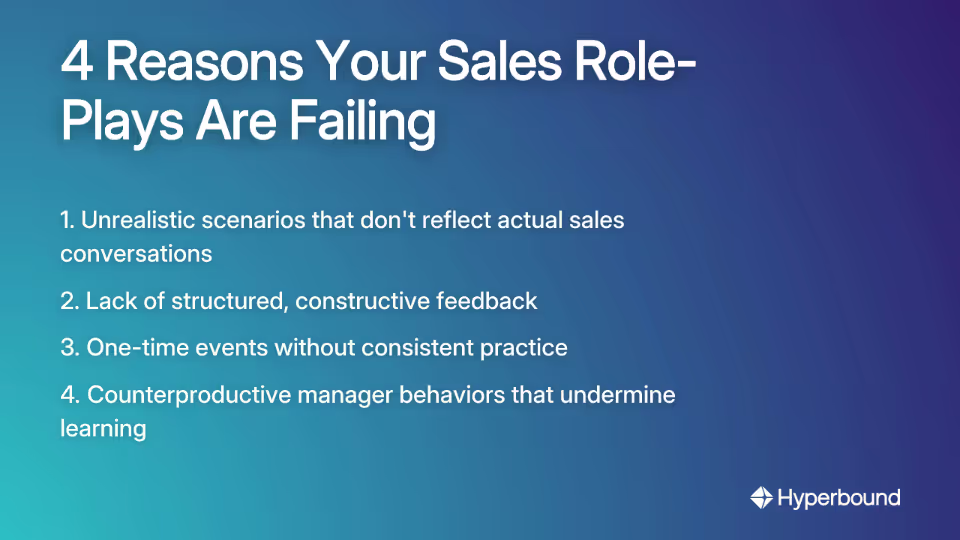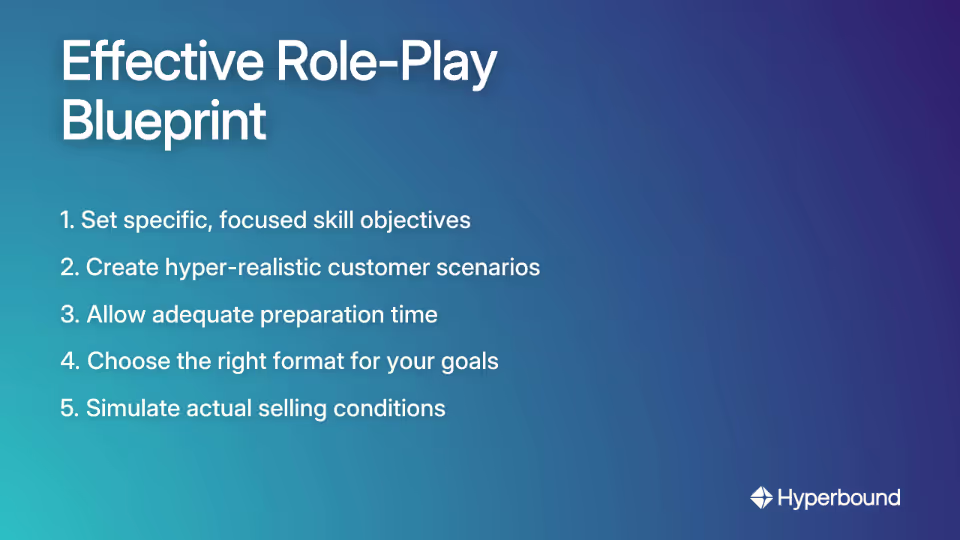
You announce "Let's do some role-playing" and watch your sales team visibly cringe. The collective groan is almost audible as eyes dart to the floor, hoping to avoid being selected first.
Sound familiar?
Let's be honest - most sales role-plays are painful exercises that leave both managers and reps feeling awkward and questioning their value. Your reps are right to be skeptical. If your role-plays don't mirror the actual challenges they face daily, you're wasting everyone's time.
"Role-playing feels 10x harder than actual sales calls," as one rep put it on Reddit. "It's unauthentic and unproductive because we're not actually selling anything."
This article isn't about incremental tweaks. It's about transforming role-plays from dreaded exercises into your most powerful coaching weapon. We'll diagnose what's broken and build a system that actually prepares your team for real-world objections and challenges.
Why Your Current Role-Plays Are Failing
Before we fix the problem, let's understand what's going wrong. Here are the four horsemen of failed role-plays:

1. They Feel Fake and Unrealistic
Your reps are selling complex solutions to sophisticated buyers with unique needs. Yet your role-plays feature softball scenarios with generic objections that don't reflect reality. This disconnect makes the entire exercise feel pointless.
As one sales professional noted, "The inability to accurately replicate real customer interactions lessens the effectiveness" of role-playing exercises.
2. There's No Real Feedback (Or It's Just Criticism)
A role-play without structured, constructive feedback is just performance art. Too often, managers use role-plays as opportunities to criticize rather than coach. A common pitfall is using role-playing as a means to criticize or berate salespeople, rather than treating it as a coaching opportunity.
3. They're One-and-Done Events
Skills aren't built in a single, annual training session. Without repetition and reinforcement, learning evaporates. Research shows that deliberate practice requires consistency over time - not one-off performances.
4. The Manager Is Part of the Problem
Many sales managers unintentionally sabotage role-plays by:
- Dominating conversations instead of listening
- Playing unrealistically difficult or easy "customers"
- Practicing "helicopter management" by jumping in to fix every mistake
- Creating an environment where failure feels unsafe
To avoid undermining the learning process, managers need to limit talking and increase listening.
Building the Foundation: Psychological Safety First
Before running a single scenario, you must establish trust. Your reps won't be vulnerable and take risks if they fear criticism or humiliation.
The First Principle: Safety Over Judgment
Create a supportive atmosphere that encourages learning without fear of criticism. The goal is coaching, not catching people making mistakes. This shift in approach can transform role-plays from awkward exercises into valuable learning experiences.
Lead by Example
The best way to reduce awkwardness is for leaders to participate first. Implement a two-part structure: First, leaders showcase the role-play, then the team breaks into smaller groups to practice. This normalizes the activity and sets the standard for authentic participation.
Set the Right Tone
Frame role-playing as a laboratory, not a final exam. It's a space to experiment, fail, and learn without consequence. When properly executed, role-playing boosts confidence by identifying areas for improvement without the stress of a live deal on the line.
The Blueprint: A Step-by-Step Guide to Effective Role-Plays
Now let's build a practical framework that transforms your role-plays from painful to productive:

Step 1: Set Specific, Laser-Focused Goals
Don't try to boil the ocean. A single role-play can't fix everything. Instead, focus on one or two specific skills per session:
- Delivering a compelling value proposition
- Handling a particular objection
- Asking better probing questions
- Negotiating pricing without discounting
This aligns with what reps actually want. Instead of full, meandering role-plays, many prefer to "just simulate the objection handling during meetings" and focus on refining responses to common challenges that stall deals, according to sales reps themselves.
Step 2: Build Hyper-Realistic Scenarios
Generic scenarios are useless. Your scenarios must be grounded in the reality your team faces every day. For each role-play:
- Clearly define the prospect's role, title, industry, and specific challenges
- Equip the person playing the prospect with detailed information and specific objections
- Crowdsource scenarios from your team's actual experiences
Here are five realistic scenarios to implement:
- The Price Haggler: "Your competitor is offering a 25% discount. Can you match that?"
- The Deadline Pusher: "I need this implemented in two weeks."
- The Feature Fanatic: "I really need X feature, which you don't offer."
- The Indecisive Prospect: They keep asking for more information without committing.
- The Last-Minute Objection: Just before signing, they say, "I just heard about a competitor's new feature."
Step 3: Allow Time for Preparation
Ambushes create anxiety, not learning. Give your reps adequate time to prepare their strategy, questions, and talking points. This isn't a "pop-quiz" unless that is the specific, stated goal.
Step 4: Choose the Right Format
Vary the format to keep things engaging and match the learning objective:
- Dyad Role-Play: One-on-one (salesperson vs. customer). Simple and focused.
- Triad Role-Play: Adds a third person as an observer who focuses solely on providing feedback.
- Fishbowl Role-Play: A small group performs while the larger group observes. The observers then provide feedback.
Step 5: Practice the Way You Sell
If your SDR team makes calls, the role-play should be over the phone. If your AE team does Zoom demos, practice on Zoom. Mimic real conditions as closely as possible to create genuine interaction and build emotional intelligence that transfers to real sales situations.
The Feedback Loop: Turning Practice into Performance
Even the most realistic simulation is worthless without proper feedback. Here's how to transform your feedback process:
The Golden Rule: Let the Receiver Go First
Before you say a word, ask the rep to identify two things they did well and two areas they'd like to improve. This encourages reflection and self-awareness, transforming the dynamic from critique to self-assessment.
This simple change creates a receptive environment for the constructive points that follow.
Start with the Positive
Always begin your feedback by highlighting two positive observations. This isn't just being nice – it creates psychological safety and makes reps more receptive to constructive criticism.
Use the SMART Framework for Actionable Feedback
Vague feedback like "be more confident" is useless. Your feedback must be concrete. Ensure all feedback is:
- Specific: "When the prospect mentioned price, you immediately jumped to a discount instead of asking about their budget."
- Measurable: "Next time, try to ask at least three probing questions before mentioning price."
- Achievable: The suggested change should be within the rep's control.
- Realistic: The goal should be improvement, not perfection.
- Timely: Give feedback immediately after the role-play, when it's still fresh.
Making It Stick: Habit, Repetition, and Technology
Make It a Habit, Not a Spectacle
The power of role-playing comes from consistent, low-stakes practice, not a high-pressure annual event. Schedule regular, short role-play sessions (e.g., 30 minutes in weekly team meetings) to normalize the practice and build confidence over time.
Record and Review: The Power of "Film Review"
Just like athletes watch game tape, reps can learn immensely from watching themselves. Record role-play sessions (with consent!) and have reps review their own performance first. This is a powerful tool for self-discovery.
However, be transparent. Using personal call recordings for training without consent causes surprise and discomfort, according to sales professionals.
Leverage Technology for Scale and Realism
Modern tools can solve many of the traditional challenges of role-playing:
- AI-powered platforms like Hyperbound provide dynamic, realistic AI buyer personas for reps to practice with on-demand. These platforms can analyze your actual sales calls to create hyper-realistic scenarios, ensuring reps practice what they'll actually face.
- Other tools, such as Secondnature.ai and CharacterAI, can also be used to create practice bots, giving reps a way to practice without scheduling a live session.
These technologies directly address the desire for more authentic practice opportunities while removing the social pressure that makes traditional role-plays so uncomfortable.

From Dreaded Task to Strategic Advantage
Stop running role-plays that make your team feel judged, awkward, and unprepared. By building a foundation of psychological safety, using realistic scenarios, providing structured feedback, and embracing consistency, you can transform role-playing from your team's most hated activity into your most valuable coaching asset.
This isn't about checking a training box. It's about equipping your salespeople with the confidence and skills to handle any conversation, navigate tough negotiations, and ultimately, close more deals. It's about helping them find their unique voice, because as one sales professional observed, training is ineffective if a salesperson can't be authentic.
The choice is yours. Continue with the painful, ineffective role-plays that everyone dreads, or adopt a structured, coaching-focused approach that builds a high-performing, confident, and resilient sales team.
Your reps will thank you. And so will your bottom line.
Frequently Asked Questions
What is the biggest mistake managers make with sales role-plays?
The single biggest mistake is using unrealistic scenarios that don't reflect the actual challenges reps face. This disconnect makes the exercise feel fake and unproductive. To be effective, role-plays must be built on hyper-realistic customer profiles and objections, often crowdsourced from the team's real-world experiences.
How can I make sales reps feel less awkward about role-playing?
You can reduce awkwardness by establishing psychological safety. Create a supportive, judgment-free environment where the goal is coaching, not criticism. A powerful way to achieve this is for managers to lead by example—participate in the first role-play yourself to demonstrate vulnerability and set a positive, collaborative tone.
How often should my team do sales role-plays?
Sales role-plays should be a consistent, regular habit, not a one-time event. Short, frequent sessions, such as a focused 30-minute practice during a weekly team meeting, are far more effective than a single, high-pressure annual training. Consistency builds skills and confidence incrementally over time.
What is the best way to give feedback after a role-play?
The best way to give feedback is to let the sales rep self-assess first. Ask them to identify what they did well and what they'd like to improve before you offer your input. When you do provide feedback, always start with positive observations and then use a structured framework like SMART (Specific, Measurable, Achievable, Realistic, Timely) to deliver actionable advice.
How do I create realistic role-play scenarios?
Create realistic scenarios by grounding them in your team's actual sales situations. Crowdsource recent objections and challenging deals directly from your reps. For each scenario, define the prospect's profile (role, industry, pain points) and equip the person playing the prospect with specific objections they must raise, such as pricing pressure or requests for features you don't offer.
How can AI help with sales role-playing?
AI technology revolutionizes sales role-playing by providing scalable, on-demand practice opportunities. AI-powered platforms like Hyperbound create realistic AI buyer personas for dynamic conversations, allowing reps to practice anytime without a partner. These tools offer instant, unbiased feedback, removing the social pressure and logistical hurdles of traditional role-plays.

Book a demo with Hyperbound
.png)













